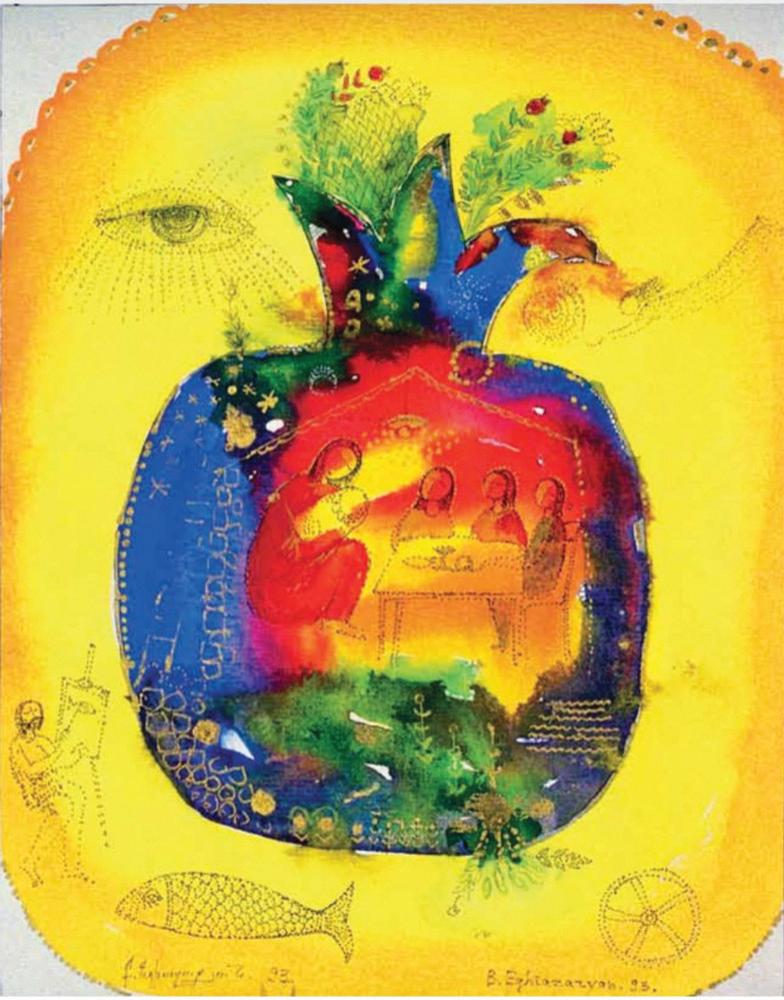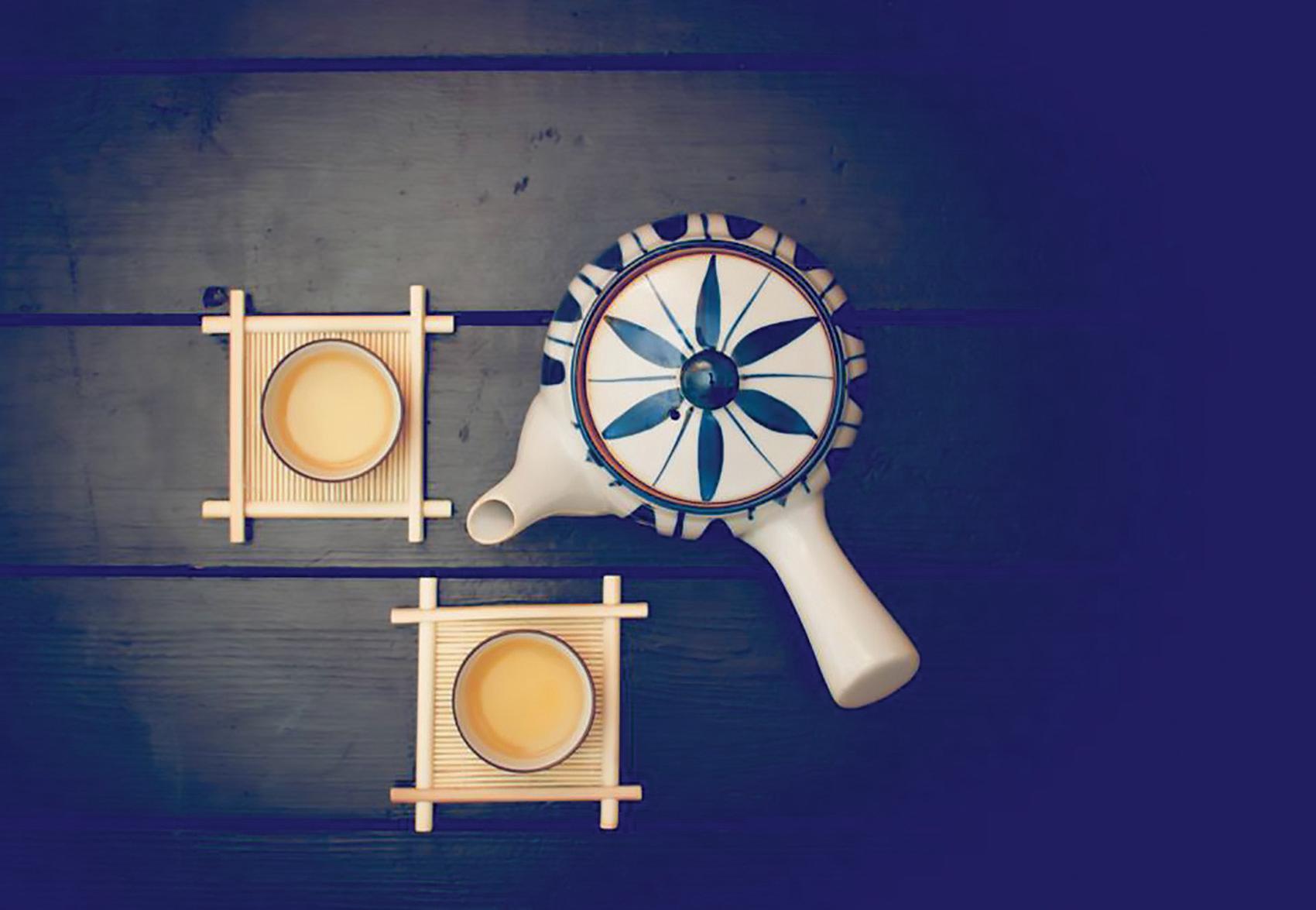
9 minute read
Beyond the Frames
Art Called Boris Yeghiazaryan
By Christina Ghevondian
Advertisement
Human and professional, mysterious and simple, spiritual and full of love, a most outstanding artist: Boris Yeghiazaryan.
If you do not know who Boris Yeghiazaryan is, you may pass over his name, but once you know him, it is impossible to be indifferent to him and his art. Do not try to look at his works separate from him. He is not just an artist and painter, he is the art himself; he is the creator, the beginning and continuation of the unique and spiritual “Boris Yeghiazaryan” world. His aura, his manners, his world, his faith, his symbols, and his masterpieces together create the art called Boris Yeghiazaryan. Boris Yeghiazaryan is an Armenian-Ukrainian painter living and working in Kiev, Ukraine. Although he was born and raised in Armenia, for many years he has been living in Ukraine.
It is impossible to give any complete definition to the phenomenon called “Boris Yeghiazaryan.” You can only feel him through talking to him, listening to his talks, reading his interviews, watching documentaries about him, and eventually exploring his masterpieces. He will take you to his world full of love and happiness.
If you look at his recent works, you will think that Boris had the happiest and best life. Yet he has had a life full of hardships, one that has made him kinder and thankful for everything. His love for art was so big that for some time he was forced to be far from his most beloved wife and baby girl Lusine.
Boris Yeghiazaryan in his studio.
Boris’s academic journey started at the Terlemezyan College of Creative Art in 1974 in Armenia. He then continued his studies at the Mukhina Art Institute in St. Petersburg, and his last destination was the Academy of Art in Kiev, from which he graduated in 1986.
Back in Armenia, Boris participated in the Artsakh Movement (1988–1992) that later transformed into the Pan-Armenian National Movement for the unification of Armenian territories. Because of this participation, he was stalked by the KGB, taken to jail, and then experienced the worst that could happen to any artist: They brunt his studio with his works from the preceding ten years.
Throughout his life, Boris’s works have differed according to his mental and spiritual state. After the war, he suffered from depression, and it took quite a long time for him to return to a life of art and to be able to create something new again.
Boris also suffered one of the worst nightmares that parents can experience. His lovely daughter, Lusine, tragically perished in a car accident. It was the love of God that saved him and gave him and his wife the strength to live and create.
In 2013–2014, he actively participated in and was injured during the Euromaidan demonstrations in Kiev, demonstrations that sought the implementation of an association agreement with the European Union. Boris is always quite active both socially and politically.
An additional ordeal was ahead of him. In 2020, he was diagnosed with stage IV cancer. His friends started a fundraising campaign for his treatment, but he used some of this donation to start a campaign for other people suffering from cancer. At the end of 2020, war broke out again in Armenia. A huge number of soldiers sacrificed their lives and many were severely injured. Due to circumstances, Boris could not participate this time. However, while struggling with his disease, he painted day and night, selling his works for the rehabilitation of wounded soldiers, for their families, and for the families of those who died.
Different stages of his life certainly had an impact on his works. He never puts himself in any frame. He paints whatever he feels at that moment. His sister, art historian Gayane Eghiazaryan, wrote about his art saying, “It is hard to put him into any kind of -ism.” He may be considered as an avant-garde artist trying to see and create beyond the boundaries. Some people have described him as a Christian artist because of his symbolism. However, there is only one way to understand his art: Just look at it as not any -ism but as Boris Yeghiazaryan’s art world. His daughter described it as “a borderless land of fine art.”
Boris is well-known not only in Armenia and Ukraine but in other countries as well. He has been participating in numerous exhibitions in Ukraine, Armenia, the U.S.A., Greece, Canada, France, Switzerland, Germany, and elsewhere since 1986. He has held many individual exhibitions, participated in group exhibitions, and was part of international art festivals. You can find his works in collections of the Kiev National Art Gallery, the Museum of Parajanov in Armenia, the National Gallery of Armenia, the Vinnitsa Museum of Art, and other galleries and museums, as well as in private collections of famous people.
The harmonious combination of bright colors is one of the key points in creating Boris’s mysterious world. His colors make the paintings come alive, as if you can see them moving

▲ Nune (1988).

▲ My Daughter Lusine (1981). ▼ Anastasia (1998).


▲ Love (1996).
and talking to you. His works are very simplistic, while containing the whole universe inside them. You can often find Christian symbols and themes, such as fish (representing Jesus), eyes (representing the eye of God), pomegranates (representing the church), angels, the color gold (representing light and purity in medieval Christian art), light (in the form of lamps, music, and violins), Noah’s Ark, and more. Colors and icons are quite static in his art. But there is no obsession with any ideology or phenomenon because nothing is planned or deliberate. He paints whatever he feels.
At an earlier stage in his career, his works were more expressionistic, showing his mental state, his inner worries, and his emotional state. It was a difficult period for Boris, and all his anxiety and worries were reflected in his works. In his earlier self-portraits, you find distorted paintings with a gloomy and desperate aura. Sadness, nursing homes, psychiatric hospitals, and portraits of old men were some of his main themes. He has a series called Psychiatric Hospital that he created by visiting hospitals, trying to understand and live through the tragedies of the patients by painting them. This left a scar on him as well.
Through all his depression and hardships, Boris found his way to God. Through all the difficulties, he found the beauty that life has to offer him and people in general. “If I am painting, that means I am praying,” Boris has said. For some period, he gave painting lessons at a school. The simplicity and sincerity of the children’s paintings were the source of inspiration for his future works. So, he has recreated the reality of beauty, love, joy, purity, peace, freedom, and happiness from the perspective of a child but as an
▼ Woman with Crocus. Portrait of Boris’ s wife (1992).

adult painter. Even aft er losing the most precious person, his daughter Lusine, he has never lost his faith and love for God, and his paintings have never lost their light and vitality.
Aft er the war, Boris started his series called Pomegranate. Not only static Christian symbols but other static fi gures can be seen in his works, such as girls with downcast eyes, kings, lions, trees, and the idea of pairs – for example, two people in a boat. His simplicity and many fi gures and symbols take us back to our childhood, “reawakening the familiar sense of harmony and safety,” as expressed by Hanni MalcotsisUrsprung (Galerie “Anixis,” Baden, Switzerland).
Let us try to understand Boris’s world through one of his works: “Love,” which has a fi gurative meaning. It includes fi gures of three women, standing for the trinity; a fi sh in the middle, symbolizing Jesus; and an eye, symbolizing the all-seeing eye of God. In contrast to the closed eyes of the women, the eye of the fi sh is open. Th is painting depicts the concept of unconditional and infi nite love, and the integration of the fi sh, the eye, and the three women forms the trinity.
Boris’s music theme is also worth a mention. It is amazing how it becomes possible to feel the music through his paintings due to the right combination of colors. Boris had the opportunity to create the icon of the Virgin Mary with Jesus for the Altar of the 4th Century Church of St. Cross in his hometown of Aparan.
Boris is not limited to oil and watercolor paintings. His art includes graphics, collages, frescos, sculptures, and mural paintings. One thread is not suffi cient to express his world.
If you want to feel happiness, love, harmony, and liveliness, explore the world of Boris Yeghiazaryan. Although he has had many exhibitions in Europe, so far there has been no opportunity to exhibit in Asia. Who knows, maybe Korea can become the fi rst Asian country to introduce Boris Yeghiazaryan’s art to its people?

▲ In the Garden (2004).
Main Awards
• In 1998, Boris was voted one of the top 20 Ukrainian Artists by the Association of Ukrainian Fine Art Galleries. • In 1999, Boris received the Diploma of the International Biographical Centre for his major contribution to 20th century fi ne art. • Boris was included among the 2,000 Outstanding Artists and Designers of the 20th Century in honor of his outstanding contribution within the artistic medium of painting.
Facebook: @BorysEghiazaryanArt or facebook.com/boris.yeghiazaryan.
References
Boris Yeghiazaryan Catalogue, 2005. Gayane Eghiazaryan, “Human and Nature in Boris Yeghiazaryan’s Art,” 1998.
The Author
Christina Ghevondian is an Armenian student at Chonnam National University. She is doing a PhD in Korean language and literature. Boris Yeghiazaryan is her uncle. She hopes that one day a Boris Yeghiazaryan exhibition will be held in Korea and people will be able to share in his wonderful world. Email: christinaghevondian@yahoo.com
▼ Pomegranate: Th e Family (1998).



Spring
By Joe Wabe
Spring is delight. It starts with a lonely, melodious minstrel of a bird, which is soon echoed in the nearby trees by other singers. Th e world awakes to a universe of colors and blue skies, and a mantel of warm and fragrant ambience embraces us with hope – hope that renews our spirit and soul from the lonesome and frigid winter. Th e symphony of colors and fragrances is a beautiful reminder from Mother Earth that it is time to revive.
The Photographer
Joe Wabe is a Gwangju expat who has been contributing to the GIC and the Gwangju News for more than ten years with his work in photography and writing.
















